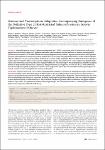Genome and Transcriptome Adaptation Accompanying Emergence of the Definitive Type 2 Host-Restricted Salmonella enterica Serovar Typhimurium Pathovar
Kingsley, Robert A.
Kay, Sally
Connor, Thomas
Barquist, Lars
Sait, Leanne
Holt, Kathryn E.
Sivaraman, Karthi
Wileman, Thomas
Goulding, David
Clare, Simon
Hale, Christine
Seshasayee, Aswin
Harris, Simon
Thomson, Nicholas R.
Gardner, Paul
Rabsch, Wolfgang
Wigley, Paul
Humphrey, Tom
Parkhill, Julian
Dougan, Gordon
Salmonella enterica serovar Typhimurium definitive type 2 (DT2) is host restricted to Columba livia (rock or feral pigeon) but is also closely related to S. Typhimurium isolates that circulate in livestock and cause a zoonosis characterized by gastroenteritis in humans. DT2 isolates formed a distinct phylogenetic cluster within S. Typhimurium based on whole-genome-sequence polymorphisms. Comparative genome analysis of DT2 94-213 and S. Typhimurium SL1344, DT104, and D23580 identified few differences in gene content with the exception of variations within prophages. However, DT2 94-213 harbored 22 pseudogenes that were intact in other closely related S. Typhimurium strains. We report a novel in silico approach to identify single amino acid substitutions in proteins that have a high probability of a functional impact. One polymorphism identified using this method, a single-residue deletion in the Tar protein, abrogated chemotaxis to aspartate in vitro. DT2 94-213 also exhibited an altered transcriptional profile in response to culture at 42°C compared to that of SL1344. Such differentially regulated genes included a number involved in flagellum biosynthesis and motility. IMPORTANCE Whereas Salmonella enterica serovar Typhimurium can infect a wide range of animal species, some variants within this serovar exhibit a more limited host range and altered disease potential. Phylogenetic analysis based on whole-genome sequences can identify lineages associated with specific virulence traits, including host adaptation. This study represents one of the first to link pathogen-specific genetic signatures, including coding capacity, genome degradation, and transcriptional responses to host adaptation within a Salmonella serovar. We performed comparative genome analysis of reference and pigeon-adapted definitive type 2 (DT2) S. Typhimurium isolates alongside phenotypic and transcriptome analyses, to identify genetic signatures linked to host adaptation within the DT2 lineage.
Dateien zu dieser Publikation
Keine Lizenzangabe

